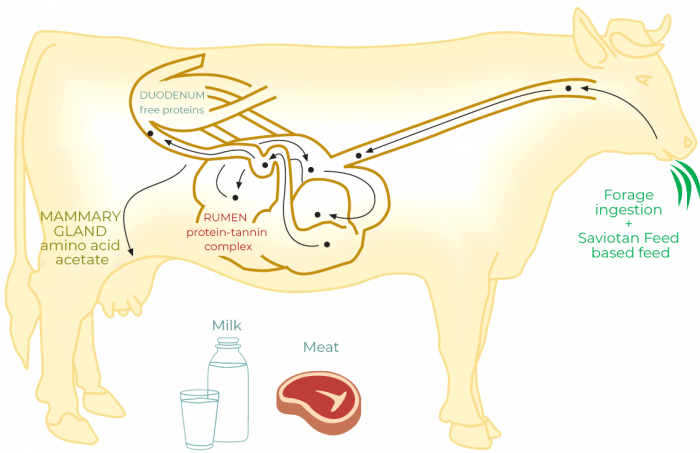Improvements in feed efficiency in cattle
Saviotan® Feed complex selects dietary proteins at rumen level, thus increasing the non-degradable proteins quota (quota-by-pass) which frees in the digestion a pool of amino acids of excellent biological value, as demonstrated by our experimental tests. There is a reduction in the loss of nitrogenous substances in the rumen via the urine, improving the efficiency of the total nitrogen balance.
Saviotan® Feed interferes in both microbial and animal lipid metabolism, favouring the production of acids used in the production of milk (acetic, rumenic and vaccenic acids), in addition, methanogenesis is reduced, as has been seen from our experimental tests.
The decrease in methanogenesis is also an advantage in meat production.


Effects on bovine health
CONTROL OF OXIDATIVE STRESS IN THE TRANSITION PERIOD (PERIPARTUM)
In the delicate period between the 20 days before and the 20 days after calving, the cows are subject to so-called oxidative stress. This is caused by abnormal production of free radicals, consequent upon the increase in metabolic activity typical of this period.
Consequences range from the diminished immune defenses to a drop in milk production at the peak of lactation.
The use of Saviotan® Feed makes it possible to manage this critical period successfully due to its notable ability to neutralise free radicals.
The effects are evident both on the general well-being of the animal (decrease in oxidation derivatives at the plasma level), and on the quality values of the milk and meat (with a reduction in the content of somatic cells).
CONTROL OF INTESTINAL PARASITES
The use of Saviotan® Feed has achieved notable results in the control of coccidia, clostridia and other pathogens.
Improvements in fat quality
The action of Saviotan® Feed on the ruminal microbiotic component positively changes the proportions of functional fatty acids, facilitating greater synthesis of unsaturated fatty acids (rumenic acid, CLA*)
*CLA: Conjugated linoleic acids.
Changes in the content of polyunsaturated fatty acids
VACCENIC ACID
RUMENIC ACID






